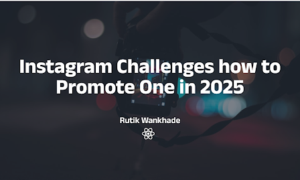In a world where attention spans are dwindling and competition for consumer engagement is fierce, video marketing has become a powerful tool for businesses looking to make an impact. By incorporating effective video marketing strategies into your overall marketing plan, you can not only capture the attention of your target audience but also maximize your return on investment (ROI). In this blog post, we will explore how to leverage the power of video to drive results and increase brand awareness.
Introduction to Video Marketing
In today’s digital age, video marketing has become an essential tool for businesses to reach and engage with their target audience. With the rise of social media platforms and the increase in online video consumption, incorporating video into your marketing strategy is no longer optional. In fact, according to a report by Cisco, videos will make up 82% of all internet traffic by 2022.
But what exactly is video marketing? Simply put, it is the use of videos to promote a product, service, or brand. This can range from short advertisements and explainer videos to behind-the-scenes footage and customer testimonials. The goal of video marketing is to connect with viewers on an emotional level, capture their attention, and ultimately drive them towards taking action.
Why use video marketing?
The power of video lies in its ability to convey information quickly and effectively. According to a study by HubSpot, 72% of people would rather watch a video about a product than read about it. This is because videos are more visually appealing and engaging compared to text-heavy content.
Moreover, videos have been found to increase consumer trust in brands as they provide an authentic look at the company behind the products or services being offered. It also allows for better storytelling, which can create an emotional connection with viewers. By tapping into emotions such as humor or empathy, businesses can establish a strong connection with their audience, leading to higher brand loyalty and ultimately increased ROI.
Why is video marketing effective?
Video marketing has become increasingly popular in recent years, and for good reason. It is a highly effective tool for businesses to reach and engage with their target audience. In this section, we will explore the reasons why video marketing is so effective and how it can help maximize your return on investment (ROI).
1. Engages all senses
One of the main reasons video marketing is so effective is that it engages multiple senses at once. Unlike text or images, videos can stimulate both the visual and auditory senses simultaneously. This makes it easier for viewers to process information and retain it as compared to other forms of content.
2. Captures attention
In today’s fast-paced world, where people are bombarded with information from all directions, capturing and retaining attention is crucial for businesses. Video marketing does just that by providing visually appealing content that can quickly grab a viewer’s attention within the first few seconds.
3. Builds trust and credibility
Videos have the power to convey emotions, personality, and authenticity, which can help build trust with potential customers. By showcasing real people, products, or services in action through videos, businesses can establish credibility among their target audience.
4. Increases conversion rates
According to research by Wyzowl, 84% of consumers said they were convinced to make a purchase after watching a brand’s video. The combination of engaging visuals, emotional appeal, and product demonstrations in videos can significantly increase conversion rates for businesses.
5. Boosts SEO Ranking
Videos have been found to improve website search engine optimization (SEO) ranking on Google due to increased user engagement metrics such as time spent on site, bounce rate reduction, and social shares.
6. Appeals Across Demographics
With the rise of digital platforms allowing easy access to video content across various devices such as smartphones, tablets, or laptops, video marketing appeals to different age groups, including younger generations who prefer interactive media over traditional advertising methods.
Understanding ROI (Return on Investment)
Return on investment (ROI) is a crucial metric for any business or marketing campaign, including video marketing. Simply put, ROI measures the profitability of an investment by comparing the amount gained to the amount invested. In terms of video marketing, ROI can help determine whether your efforts are yielding positive results and if there is room for improvement.
To truly understand ROI in relation to video marketing, it’s important to first define what constitutes a return and an investment. A return can be measured in various ways, such as increased sales, website traffic, brand awareness, or engagement. On the other hand, investments include the cost of producing and promoting the video content. It’s essential to keep track of both of these factors when calculating ROI.
One common misconception about ROI is that it only focuses on financial gains. While this is one aspect of measuring ROI, it’s not limited to monetary value alone. The returns from video marketing can also include improved brand perception and customer loyalty, which may not directly translate into immediate profits but have long-term benefits for your business.
Another factor to consider when understanding ROI is the time frame in which you measure it. Returns from video marketing may not be immediate and could take some time before they become significant enough to notice. This doesn’t mean that your efforts aren’t working; rather, it highlights the importance of giving your strategies enough time to show results before drawing any conclusions about their effectiveness.
Measuring ROI accurately requires data collection and analysis throughout the entire process, from planning and production to distribution and promotion. This includes tracking metrics such as views, engagement rates, click-through rates (CTR), conversion rates, and lead generation.
Factors that Affect ROI in Video Marketing
In today’s digital landscape, video marketing has become an essential tool for businesses to reach and engage with their target audience. It is no secret that videos have a higher engagement rate compared to other forms of content, making them a highly effective strategy for driving conversions and increasing return on investment (ROI). However, not all video marketing campaigns yield the same results. To truly maximize your ROI, it is crucial to understand the factors that can affect its success.
1. Quality of Content
The content of your video is the most critical factor that determines its success. A well-crafted and engaging video will capture the attention of your audience and leave a lasting impact, leading to higher conversions and ROI. On the other hand, low-quality or uninteresting videos are likely to be ignored and will not generate the desired results.
2. Target Audience
Knowing your target audience is crucial for any marketing campaign, including video marketing. If your video does not resonate with your target audience, it will not be effective in driving conversions and ROI. Understanding their demographics, preferences, and interests can help you create relevant and appealing videos that will yield better results.
3. Distribution Channels
Choosing the right distribution channels for your videos can greatly impact their reach and effectiveness. Different platforms cater to different audiences, so it is essential to identify where your target audience spends most of their time online. For instance, if your target audience is primarily on Instagram, then sharing your videos on that platform would be more effective than on LinkedIn.
4. Call-to-Action (CTA)
A clear and compelling call-to-action at the end of your video can significantly influence its performance in terms of generating leads and conversions. A strong CTA encourages viewers to take action.
Top Video Marketing Strategies for Maximizing ROI
Video marketing has become an essential tool for businesses looking to maximize their return on investment (ROI). With the rise of digital media and the increasing importance of visual content, incorporating video into your marketing strategy is crucial for staying relevant and competitive in today’s market. However, simply creating a video and sharing it online is not enough to guarantee a high ROI. To truly maximize your returns, you need to have a well-thought-out video marketing strategy in place.
Here are some of the top video marketing strategies that can help you optimize your ROI:
1. Understand Your Target Audience: The first step in any successful marketing campaign is to understand who your target audience is. This holds true for video marketing as well. It’s vital to know the demographics, preferences, and behaviors of your target audience so that you can create videos that resonate with them and effectively drive conversions.
2. Set clear goals: Before diving into creating videos, it’s essential to establish clear goals for what you want to achieve through your video marketing efforts. Whether it’s increasing brand awareness, driving website traffic, or generating leads, having specific objectives will help guide your content creation process and measure the success of your campaign.
3. Create engaging content: The success of your video marketing campaign ultimately depends on the quality of your content. It’s crucial to create videos that are visually appealing, informative, and entertaining to capture and maintain the attention of your audience. Use storytelling techniques, incorporate humor, and keep your videos concise to make them more engaging.
4. Optimize for SEO: Just like with written content, optimizing your videos for search engines is crucial for driving traffic and increasing visibility. Use relevant keywords in your video titles, descriptions, and tags to improve your chances of ranking higher on search engine result pages (SERPs).
5. Utilize Different Platforms: Don’t limit yourself to just one platform when it comes to sharing your videos. Different platforms have different user demographics and preferences, so it’s essential to tailor your content accordingly. Share your videos on social media platforms like Facebook, Instagram, Twitter, and LinkedIn to reach a wider audience.
Tips for Implementing Video Marketing Strategies
Video marketing has become an essential part of any successful business strategy. It offers a unique and engaging way to connect with your target audience, increase brand awareness, and drive sales. However, like any other marketing tactic, implementing video marketing strategies requires careful planning and execution to achieve optimal results. In this section, we will discuss some important tips that can help you effectively implement video marketing strategies and maximize your ROI.
1. Define Your Goals: Before jumping into creating videos, it is crucial to clearly define your goals for using video marketing. Are you looking to increase website traffic? Boost product sales? Improve brand recognition. By setting specific and measurable goals, you can create targeted videos that align with your objectives.
2. Know Your Audience: Just like with any other type of content, understanding your target audience is key to creating effective videos. Conduct market research or use data analytics tools to gain insights into the demographics, interests, and behaviors of your audience. This information will guide the type of videos you should create and the platforms where they are most likely to be consumed.
3. Create High-Quality Videos: In the age of smartphones, it is easier than ever to create videos. However, quality matters when it comes to video marketing. Poorly produced videos can reflect poorly on your brand and turn off potential customers. Invest in professional equipment or hire a videographer if needed to ensure your videos are of high quality.
4. Keep It Short and Engaging: Attention spans are short, especially online. Keep your videos concise and engaging to capture and maintain the viewer’s attention. A good rule of thumb is to keep your videos under two minutes and make sure the most important information is communicated within the first 10 seconds.
5. Optimize for SEO: Video content can also help improve your search engine rankings. Make sure to optimize your video titles, descriptions, and tags with relevant keywords to increase visibility and reach a wider audience.
Conclusion
Video marketing is a powerful tool that can help businesses maximize their ROI and achieve their marketing goals. By incorporating effective video marketing strategies into your overall marketing plan, you can reach a wider audience, engage them in a more meaningful way, and ultimately drive conversions.



































